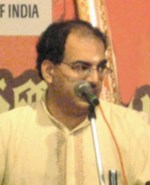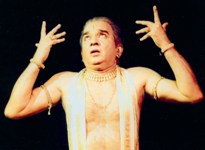NEWS & NOTES
Friday Review November Fest Varied, interesting fare
- V. RAMNARAYAN
The Hindu Friday Review November Fest 2008 offered interesting fare, starting with a quaint inaugural 35-minute concert by Swiss violinist Paul Giger on 13th November. The audience response to this performance of "the haunting sounds of the Swiss Alps" varied from the appreciative to the amused.
The introduction of a programme of old Hindi film songs was a masterstroke that the Chennai audience welcomed with great eagerness. Of the four vocalists who took part, Srinivas and Anuradha Sriram came off with flying colours, obviously familiar as they were with the songs they must have enjoyed growing up. The other two, Naresh Iyer and Chinmayi, could not equal in authenticity the sincerity of their attempts - not having internalised the old numbers sufficiently, perhaps.
MAIN FEATURE

Season 2008-09
Voices in the season - V. RAMNARAYAN
The indomitable spirit of the Chennai music season prevailed over the gloom of the recent past in yet another demonstration of the city’s commitment to the festival, bigger this year than before. It is no longer the December season, stretching as it does from November to near-February, leading us once again to question the need for such a packed, prolonged schedule of events. Does it amount to overkill, a confusing choice of plenty beyond the human capacity to absorb and enjoy? Is quantity achieved at the expense of quality? Do the performers themselves suffer from overexposure?
The answer to all three questions seems to be an overwhelming ‘yes’, to go by the responses of members of the Sruti parivaar who set out with enthusiasm and an open mind to savour the wide variety of entertainment on offer, but soon succumbed to aesthetic fatigue. The critique of the mega event that follows is largely based on the concerts and lectures this writer attended, though guided also by the observations of Sruti’s roving critics.
STATE OF THE ART

Keeping dance alive
Problems and prospects - V.P. DHANANJAYAN
In treatises on Indian theatre traditions, natya has been described as a group effort to educate the illiterate, to enlighten the literate and entertain the enlightened. ‘Drisya kavya’ or visual media was an integral part of our system of education. The divine theory of origin of natya enunciated in the Natya Sastra clearly states the concept, method and purpose of this group activity. Group presentations in any form of art or activity had a positive impact on the human mind and were common through the ages. They prevailed until modern man started becoming more and more individualistic.
Economic conditions also contributed to the fragmentation of theatre groups. When kings, landlords, feudal society and temples maintained such groups of artistic activities, the artists had no problem training and maintaining a high standard of performance. All the members in a group, including the lowest of the lot, imbibed a comprehensive knowledge of the art forms they were attached to and this spirit of discipline, devotion and dedication elevated the presentation to a sublime level of spirituality. But when royal and feudal patronage started dwindling for various reasons including invasion and slavery under British rule, smaller and fragmented groups emerged, giving way to solo performances of classical dance and music concerts. As a result, in the recent past we have seen Bharatanatyam emerge as a solo presentation, which also boosted the individualistic calibre of the performing artist. The objective of this article is not to probe into the past, but to highlight the problems faced now by our performing artists in general, and Bharatanatyam artists in particular.
SPOTLIGHT

"Contemporary dance is in a deadlock": Richard Tremblay
- K.K. GOPALAKRISHNAN
Renowned Canadian contemporary dance choreographer RICHARD TREMBLAY, in the making of his new work, was recently in India under a project of the Shastri Indo-Canadian Institute, Canada.
Constantly in search of inspiration beyond the prevailing theatre forms of the West, Richard Tremblay first came to Delhi in 1975 to present one of his plays at the National School of Drama. On that special occasion, Tremblay was strongly advised by Ebrahim Alkazi, then Director of the National School of Drama, to get acquainted with Kathakali. That was also the time he was studying yoga at Rishikesh. Soon afterwards, Tremblay went to Kerala Kalamandalam for practical training. The other side of the story is that the play he performed in Delhi with his eight-member company earned him an invitation to participate in the Baltimore New Theatre Festival, which made him internationally known.
The Indian influence
"It was my urge to know about Indian culture, and to make acquaintance with pristine art forms that brought me here. To some extent, there was the incitement of a trend in the Western theatre circles to going East", says the Montreal based choreographer.


